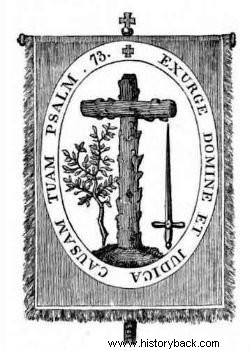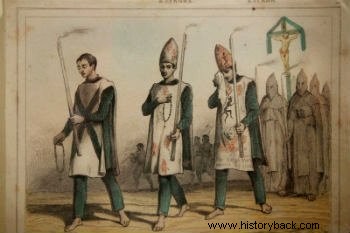The Inquisition was a political-religious movement that took place between the twelfth to the eighteenth centuries in Europe and the Americas.
The objective was to seek the repentance of those considered heretics by the Church and to condemn theories contrary to the dogmas of Christianity.
Holy Inquisition

Symbol of the Inquisition
As the Catholic Church gained more adherents during the Middle Ages, there was a need to standardize the practice of religion.
In this way, an institution was created with autonomy to investigate and judge people accused of heresy, based on the legal system of the Roman Catholic Church.
The word “heresy ” comes from the Greek and means choice. Therefore, the heretic was a faithful Christian who made a choice contrary to what the doctrine affirmed.
Many scholars consider the heretic to be a “revolutionary”, as he defended his ideas, even at the risk of being sentenced to the death penalty.
For the Church, the heretic was a sinner and therefore he should be saved at all costs. Thus, the Inquisition aimed above all, the repentance of the sinner, in this way, it is called by the Church of "Saint".
Likewise, the Inquisition was used as a control tool by the royal powers. Some sovereigns took the opportunity to get rid of their enemies through the Inquisition.
Therefore, it had a special place in nations such as France, Spain, Portugal and Italy, as well as in the colonies of Spanish and Portuguese America.
Court of the Holy Office
The Inquisition has its origins in Roman Law which the Church used to compose the Tribunal do Santo Oficio .
In 1183, the first court is used in the south of France to combat the religious sectarianism of the Cathars of Albi.
The Cathars were a sect that preached that the material world was inherently evil and must be destroyed. In this way, they encouraged suicide and abortion, in addition to the destruction of matter and the denial of pleasures.
The Court of the Holy Office was established by Pope Gregory IX, in 1233, with the aim of investigating the heresies of the Cathars, also called Albigensians.
The pontiff handed over the functioning of the Court to the Dominican Order, created by Saint Dominic.
When the Crusade against the Albigensians (1209-1244) ended, a Tribunal of the Holy Office was installed precisely to decide who was guilty or innocent individually.
The Courts of the Holy Office had the following characteristics:
- They were instituted for a specific purpose;
- They were authorized to function by the Pope or the Bishop;
- Composed of religious with theological studies.
In 1376 the “Manual of the Inquisitors ”, by Nicolas Eymerich, a Dominican religious. In this book, he described the methods inquisitors were to use to discover heresies and witchcraft.
He condemns, for example, the use of torture to extract a confession and the work has become a reference for standardizing Inquisitorial action.
Read more
- The Crusades
- Low Middle Ages
- Medieval Church
Spanish Inquisition
After the marriage of Isabel of Castile and Ferdinand of Aragon, in 1478, the two largest Hispanic kingdoms were united. These sovereigns will use the Inquisition to persecute their enemies.
In this period, thousands of Jews and Moors had to choose between being converted to Christianity, denying their beliefs or leaving the country. Those who were converted were called New Christians.
Even so, many continued to secretly practice their religion. Therefore, a Holy Office Court was installed to verify that the conversions had been sincere.
There is a myth that the Spanish Inquisition would have killed thousands of people. Recent research, however, reveals that the Inquisition in Spain, between 1540 and 1700, carried out 44,674 trials. Of these, only 1.8% (804 people) were sentenced to capital punishment.
With a similar aim, the Portuguese Inquisition was created in 1536.
Read more at Reconquest of the Iberian Peninsula.
Inquisition in Brazil
The Portuguese colony in America, Brazil, was visited by the Inquisitors on three occasions.
These came in search of New Christians who continued to practice their religious customs, adulterers, bigamists, sodomites, etc.
Read more at Inquisition in Brazil.
Protestant Inquisition
In the Modern Age, when there was a rupture between the Catholic Church and Luther, the regions conquered by the Protestants also suffered the Inquisition.
It should be noted that the term “Protestant inquisition” is used to illustrate the persecution that Calvin, Luther, or Zwglio undertook to Catholics, scientists, and humanists. But they didn't call it that themselves.
Thus, the main victims of Protestant persecution were Catholics who refused to convert to Protestantism. People accused of adultery, witchcraft and sects such as the Anabaptists were also convicted.
In the UK, several groups that did not accept Anglicanism immigrated to one of the 13 Colonies in order to continue to practice their religion.
Even so, the “Protestant inquisition” arrived in the English colonies led by pastors and religious who ran these communities.
Key Features

People condemned to wear sambenito, pray a rosary, walk barefoot and wear a conical hat parade through the streets of Seville, 19th century. XVII.
It must be remembered that the Inquisition's courts were temporary and emerged according to the need to judge cases of heresy. Often, the accused were found “randomly” and convicted just to set an example.
In addition, they were called upon to testify to the inquisitors based on complaints from third parties or on mere suspicion.
The trials were attended by a jurist and a theologian and pursued mainly Jews, Moors, witches, philosophers, scientists and mystics.
A person could be accused of:
- Heresy - doctrines or practices contrary to Catholic dogmas;
- Witchcraft - invocation of evil spirits, spells, healing by herbs considered evil;
- Continue to maintain customs of the Jewish or Muslim religions.
The punishment of heresy was carried out in the spiritual and temporal spheres. For convicts, the penalties could be imprisonment (temporary or life), wearing clothes that revealed their status as convicts (sambenitos) or, in extreme cases, death at the stake.
It is important to note that the Holy Office Court did not carry out the sentences. Once the sentence was handed down, the defendant was handed over to the secular power to be punished. At that time, the spiritual crime was considered lese-majesty and therefore, it should also be punished by the civil power.
In 1559 the list of forbidden books was created (Index Librorum Prohibitorum ), for which several philosophical and scientific works are considered inappropriate. In this way, its creators and readers could be persecuted by the Inquisition.
Main Torture Methods of the Inquisition
One of the most striking facts of the Inquisition was the use of torture as a method of investigation.
However, contrary to popular belief, approximately 10% of trials involved physical torture and no more than 2% of the accused were sentenced to capital punishment. Remembering that torture and executions were common in secular courts.
Some of the torture methods used by the Inquisition were:
- Water torture :Defendant is immobilized on his back on a table and forced to drink several liters of water through a funnel.
- Foal :the accused is placed on a bed or mat and his limbs are tied with ropes, on which a fixed rod is used as a tourniquet to press and inflict pain.
- Wheel :The suspect is tied to a wheel positioned over a brazier or several sharp barbs.
- Pendulum :the accused is arrested by the extremities of his body, suspended a few meters and dropped suddenly.
- Polé :the victim is tied by the ends of his body, which is stretched until the ligaments break.
Curiosities
- Galileo Galilei was persecuted by the Inquisition for asserting the theory of heliocentrism, but was acquitted.
- Giordano Bruno, the father of modern philosophy, and Joan of Arc were tried by the Inquisition and sentenced by secular justice to death at the stake.
- In 1904, the Catholic Church determines that the Tribunal of the Holy Office be called the "Supreme Sacred Congregation of the Holy Office". Later, in 1965, it receives the name of Congregation for the Doctrine of the Faith.
Read more
- Middle Ages
- Templars
- Modern Age
- Lutheranism
- Calvinism
- Counter-Reformation
